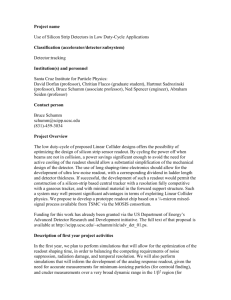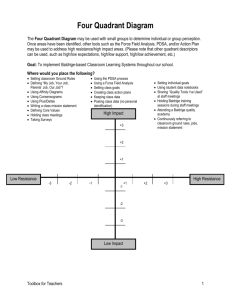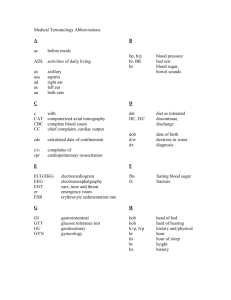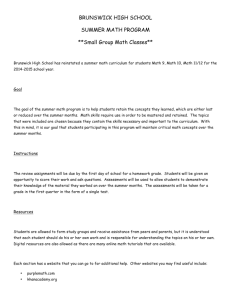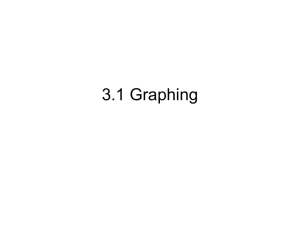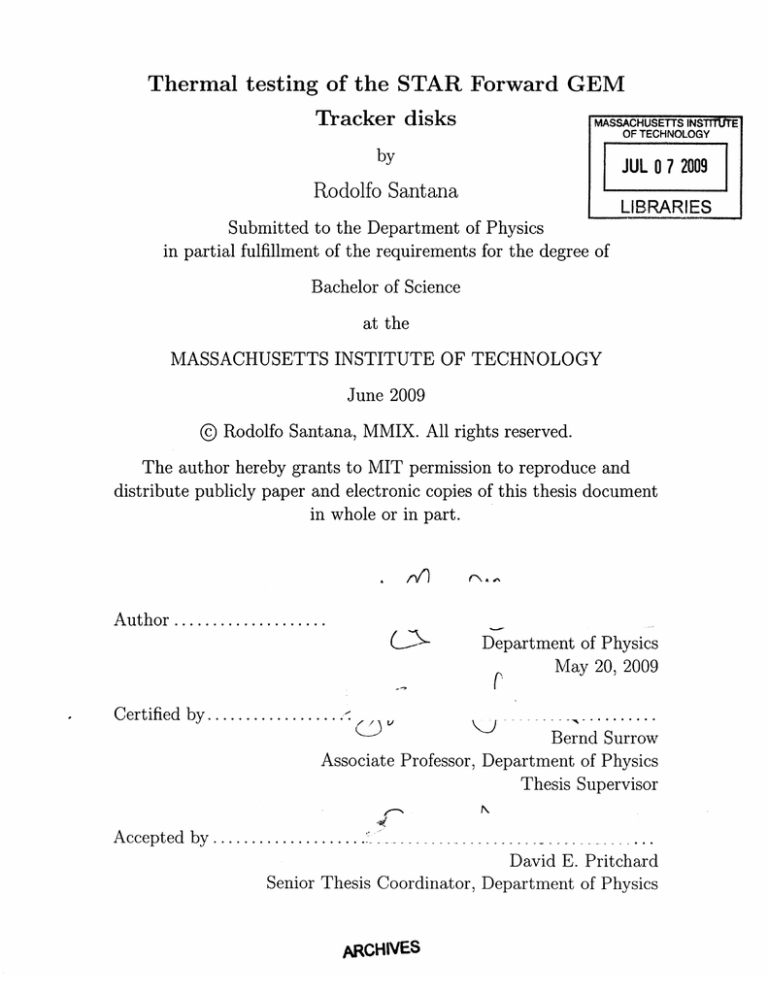
Thermal testing of the STAR Forward GEM
Tracker disks
MA
SSACHUSETTS
INSTMJTE
OF TECHNOLOGY
by
JUL 0 7 2009
Rodolfo Santana
LIBRARIES
Submitted to the Department of Physics
in partial fulfillment of the requirements for the degree of
Bachelor of Science
at the
MASSACHUSETTS INSTITUTE OF TECHNOLOGY
June 2009
@ Rodolfo Santana, MMIX. All rights reserved.
The author hereby grants to MIT permission to reproduce and
distribute publicly paper and electronic copies of this thesis document
in whole or in part.
A
rV1
(N
,
Author ....................
C'->
Certified by.................
Department of Physics
May 20, 2009
K)2
Bernd Surrow
Associate Professor, Department of Physics
Thesis Supervisor
Accepted by...................
...
David E. Pritchard
Senior Thesis Coordinator, Department of Physics
ARCHNVES
Thermal testing of the STAR Forward GEM Tracker disks
by
Rodolfo Santana
Submitted to the Department of Physics
on May 21, 2009, in partial fulfillment of the
requirements for the degree of
Bachelor of Science
Abstract
In my thesis project, I worked on the Thermal Model for the FGT detector. The
purpose of this thermal model is to simulate the cooling system for the electronics
of the FGT. In this thesis report, I go over the construction of the model disks for
the thermal model and the measurements I made on one disk. I also discuss the
LabVIEW program I worked on to monitor the temperature of the readout cards
over time. The measurements I made with the LabVIEW program concerned the
orientation of the disks. The two orientations I took measurements for were for a disk
placed upside down in a horizontal surface and for a disk placed vertically on a pipe.
After analyzing the data, I found that these two orientations have no effect on the
heating and the cooling of the readout cards.
Thesis Supervisor: Bernd Surrow
Title: Associate Professor, Department of Physics
Acknowledgments
I would first like to thank Professor Bernd Surrow for giving me the opportunity to
join his research group and work on this project. Next, I want to thank Research
Scientist Gerrit van Nieuwenhuizen for helping me with LabVIEW. Without his help,
I would have never been able to finish the DAQ program during the time of this
thesis project.
I also want to thank Gerrit for providing me with an outline for
this report and giving me great suggestions on improving this paper. I also want to
thank Project Technician Glen Dale Ross for his guidance on preparing the disks for
the Thermal Model and for answering all my questions about the Thermal Model.
Another person I want to thank is Research Scientist Douglas Hasell for his help on
telling me how to arrange the readout cards on the disks and for telling me where to
put the temperature sensors on the readout cards. Finally, and certainly not least, I
would like to thank Barry Brian Barrios for rereading, and rereading, and rereading
this paper again and for not hesitating to point out any errors he found in this thesis.
Contents
1
Introduction
13
2 Construction of Thermal Model
17
3 Measurements
25
4
3.1
Heating of Readout Cards ........................
28
3.2
Cooling of Readout Cards .........................
29
Conclusion
A LabVIEW DAQ Program
33
35
List of Figures
1-1
The picture on the left shows how the 6 disks are going to be positioned
in the FGT. On the right, and a clear view of one of the disks is shown. 14
2-1
The pipe in the thermal model which will have air flowing through it
is shown .........
2-2
. . . . . . ....
..
. .
...
.......
.. .
17
Schematic of airflow in the thermal model. The blue arrows represent
air. It can be seen that air will flow out of the pipe in a radial direction
right before the disks..................
........
18
2-3
Image of a completed disk ........................
2-4
Close up view of one of the large readout cards. . ............
2-5
One quadrant of a disk. The two large readout cards and small readout
..
cards are on the left. The medium readout card is on the right.
2-6
18
19
. . .
20
Circuit diagram for the 4 readout cards in a quadrant. It can be seen
that the resistors in each of the readout cards are in parallel and also
that the connections between all the readout cards are in parallel. The
values for the resistors are R1 = 80.6Q and R 2 = 191W.
2-7
........
.
21
On the left, banana plugs are attached to one end of a 15-feet long
cable. On the right side, the banana plugs are attached to a power
supply . . . . . . . . . . . . . . . . . . . . . . . . . . . . . . . . . . . .
2-8
20 channel cable used for attaching the temperature sensors and for
reading out the values of the temperature sensors. . ........
2-9
22
. .
23
On the left, the 20 channel cable is attached to a connector block. This
connector block was attached to the multimeter on the right. .....
23
3-1
This figure displays the two different orientations. The horizontal orientation is on the left and the vertical orientation is on the right.
. .
3-2
Measurements of disk in horizontal position with no currents......
3-3
Measurements of disk in vertical position with no currents. ......
3-4
Graph for the heating of all the quadrants in the horizontal position
at the same time . ...............
3-5
.
26
.
............
27
29
Graph for the heating of all the quadrants in the vertical position at
the same time ...............................
3-6
25
30
Graph for the cooling of all the quadrants in the horizontal position at
the same time ...............................
31
3-7 Graph for the cooling of all the quadrants in the vertical position at
the same time ...............................
32
A-1 Figure of LabVIEW Front Panel. ....................
36
A-2 Block diagram of the part of the LabVIEW program that tells the
multimeters to scan the temperature sensors and the part that converts
resistances to temperatures. .......................
A-3 Temperature readings are converted into double variables.
37
. ......
38
A-4 The temperature readings are inserted into an array with 40 elements.
Then, this array is split into 10 arrays with 4 elements to each array.
Finally, the 10 arrays are plotted in waveform graphs. . .........
39
List of Tables
A.1 Values for the coefficients a, b, c, for different ranges of temperatures
for the temperature sensors we used.
. ..................
38
12
Chapter 1
Introduction
The Solenoidal Tracker at RHIC (STAR) is one of two large detector systems constructed at the Relativistic Heavy Ion Collider (RHIC) at Brookhaven National Laboratory (BNL). The STAR physics program at RHIC can be divided into three main
categories: a study of high density QCD, measurement of the spin structure function
of the proton, and a study of photon and pomeron interactions from electromagnetic
fields of the passing ions at RHIC [1]. The spin physics program at RHIC at BNL
focuses on the collision of polarized protons to gain a deeper understanding of the
spin structure and dynamics of the proton. Recent results of the RHIC also provide
strong evidence for the formation of a new state of strongly interacting matter. [2]
A tracking detector is currently being prepared by the STAR collaboration at
BNL. This upgrade will allow for further investigations of the fundamental properties of a new state of strongly interacting matter produced in relativistic-heavy ion
collisions at RHIC and it will allow for fundamental studies of the proton spin structure and dynamics in high-energy polarized proton-proton collisions at RHIC. The
approved Forward GEM (Gas-Electron Multiplier) Tracker (FGT) project will focus
on novel spin physics measurements in high energy polarized proton-proton collisions.
The FGT upgrade to the STAR experiment is needed to provide the required
tracking precision for charge sign discrimination. This upgrade will consist of six
triple-GEM detectors with two dimensional readout cards arranged in disks along the
beam axis (Z). A Schematic diagram of the 6 disks of the FGT project and a picture
of the surface of one disk are given in Figure 1-1.
Figure 1-1: The picture on the left shows how the 6 disks are going to be positioned
in the FGT. On the right, and a clear view of one of the disks is shown.
This configuration provides a rather cost effective solution based only on tripleGEM technology. GEM technology is widely employed by current and future experiments in nuclear and particle physics. Prototype test detectors of the FGT project
have been successfully tested in a test beam experiment at FNAL (Fermi National
Accelerator Laboratory) including the final chip readout system.
The readout electronics of the FGT detector will consist of APV25-S1 readout
chips [3]. APV25-SO chips, older versions of the APV25-S1 chips, were used successfully with GEM detectors in the COMPASS (Common Muon and Proton Apparatus
for Structure and Spectroscopy) Experiment at CERN [4]. These APV (Analogue
Pipeline Voltage) chips will be connected to the readout cards in the FGT. Each of
these APV chips will generate an 12 R heating of about 1/3 Watts. This means that
the 6 disks in the FGT will generate dissipation heating of about 144 Watts. To cool
the readout electronics of the FGT detector, there will be an air cooling system.
For this thesis project, I worked on setting up a cooling test to simulate the
performance of the FGT air cooling system. This model for the FGT air cooling
system will be referred to as the Thermal Model. In the thermal model, the heat
sources (APV chips) will be modeled by resistors. The specific parts of the thermal
model I worked on were the completion of the 6 model disks of the FGT, the writing
of a data acquisition program to monitor the temperatures of the readout cards, and
the testing of the heating and cooling of one of the 6 model disks.
16
Chapter 2
Construction of Thermal Model
The thermal model in its current state is shown in Figure 2-1. This model consists of
Figure 2-1: The pipe in the thermal model which will have air flowing through it is
shown.
a big pipe suspended in a cradle. Air will be flown inside the pipe and some of this air
will flow out of 1-inch diameter holes to cool the readout cards. A schematic of how
the airflow will go through the model is shown in Figure 2-2. The 1-inch diameter
holes will be drilled on the pipe right before the locations of the disk so that the air
can escape and cool the readout cards. To vary the airflow through the holes, sheets
of plastic will be put on the pipe. These plastic sheets, or collars, will be able to slide
over the holes to adjust their sizes.
.
+
-
.. . .
.. ,-
,
,(
4----
4-
-
4--
4
--
Figure 2-2: Schematic of airflow in the thermal model. The blue arrows represent air.
It can be seen that air will flow out of the pipe in a radial direction right before the
disks.
One of the tasks I completed while working on this thesis project was putting all
the components onto the 6 disks. The disks of the thermal model were made out of
wood and painted white. A picture of one disk with all the components attached is
shown in Figure 2-3. The big hole in the middle of the disks was made so that the
Figure 2-3: Image of a completed disk.
disks can fit tightly into the pipe.
The first component of the disks I worked on was preparing the readout cards.
There are 3 different types of readout cards which we can be distinguished by their
sizes. The small readout cards and the medium readout cards each take four 80.6Q
resistors. Large readout cards each take five 191Q resistors. A close up view of one
of the large readout cards is now shown in Figure 2-4. In this picture, the numbered
eamperat
2
3
5
Figure 2-4: Close up view of one of the large readout cards.
arrows on the bottom point to the five resistors. The method I used to attach the
resistors to the readout cards was soldering. After the resistors were soldered, terminal
connectors were soldered on both ends of the readout cards. One terminal connector
is also pointed out in Figure 2-4. The cables through which current will run to heat
up the resistors are the black and white cables connected to the terminal connectors
in Figure 2-4.
Now that the readout cards were prepared, I moved on to attaching the readout
cards to the disks. The surfaces of each disk are separated into 4 quadrants. In each
quadrant, two large readout cards, one medium readout card, and one small readout
card are attached. For clarity, Figure 2-5 shows the configuration of the readout cards
in one quadrant.
In this picture we see that the large readout cards are placed side by side. The
small readout card is placed at the edge of the disk so that its center is in between the
two large readout cards. Finally, the medium readout card is also placed at the edge
Figure 2-5: One quadrant of a disk. The two large readout cards and small readout
cards are on the left. The medium readout card is on the right.
of the disk and to the right of the other three readout cards. After I had one quadrant
prepared, I moved on to attaching the readout cards to all remaining quadrants for
all 6 disks.
Now that the readout cards are in place, I will discuss the circuit in each quadrant.
The circuit diagram for the configuration of readout cards is given in Figure 2-6. The
power supply is connected to the medium readout card. The medium readout card
is then connected to the small readout card in parallel. This small readout card was
then attached to one of the large readout cards in parallel. Finally, the two large
readout cards were also connected in parallel.
To connect the medium readout cards to the power supply, I attached four 15-feet
long cables to the disks. These four cables are the 4 gray cables rolled up in circles in
Figure 2-3. One of the ends of these cables was attached to one of the terminal blocks
in the medium readout card. Banana plugs were placed on the other end of each of
the 15-feet long cables to connect these cables to the power supply. A picture of this
end of the cable is shown in Figure 2-7. The power supplies we used were Hewlett
Packard E3614A Power Supplies [5] and one of them is also shown in Figure 2-7.
The final step to complete the preparation of the disks was the preparation of the
temperature sensors. This was one of the most difficult tasks because the temperature
Figure 2-6: Circuit diagram for the 4 readout cards in a quadrant. It can be seen that
the resistors in each of the readout cards are in parallel and also that the connections
between all the readout cards are in parallel. The values for the resistors are R, =
80.6Q and R 2 = 191Q.
sensors are very small and delicate. The temperature sensors were attached to all the
channels in a cable used for reading 20 channels. A picture of this cable is shown in
Figure 2-8.
Once the temperature sensors were attached to all the channels, the temperature
sensors were attached to the disks and readout cards with tape. A temperature sensor
tapped to one of the large readout cards is pointed out in Figure 2-4. Each of the 16
readout cards on each disk received a temperature sensor. On the medium readout
cards, the temperature sensors were attached directly to a resistor to measure a quick
response in the rise of temperature. This left us with 4 extra temperature sensors.
Two of the remaining temperature sensors were attached close to the hole in the
SSEWLETT
4PACKARD
E3614A
L
+
P
SUP;ow
ADJUSI
Cirrtl
ovP
0
OUTPUT
15-feet long cable.
Figure 2-7: On the left, banana plugs are attached to one end of a
On the right side, the banana plugs are attached to a power supply.
other 2 temperature
middle of the disks to measure the incoming airflow and the
the exhaust air.
sensors were attached close to the edge of the disk to measure
block. This
The other end of the 20 channel cable was attached to a connector
[6]. This
connector block was then attached to a Keithley Model 2000 Multimeter
Figure 2-9. With
connector block and one of the multimeters we used are displayed in
sensors
the temperature sensors now connected to the multimeters, the temperature
the temperature
are now ready to be used to measure temperature. To monitor
The LabVIEW
over time, we wrote a LabVIEW DAQ (Data Acquisition) program.
discuss here what
program is discussed in full detail in Appendix A but I will briefly
the program does.
all 20
Our LabVIEW DAQ program first tells the muiltimeter to scan through
sensors.
channels. The multimeter then measures the resistances of the temperature
readings
The resistances the multimeter measures are then created to temperature
takes the
in units of degrees Celsius by the LabVIEW program. Our program then
graph. The
temperature readings for all the channels and displays them over time in a
means
4 temperature readings for each quadrant are displayed in one graph. This
displaying
that we have 4 graphs displaying temperatures over time with each graph
are displayed
4 temperature readings. The remaining 4 channels attached to the disk
temperature
in another graph. Finally, the LabVIEW program also inserts all of the
Figure 2-8: 20 channel cable used for attaching the temperature sensors and for
reading out the values of the temperature sensors.
Figure 2-9: On the left, the 20 channel cable is attached to a connector block. This
connector block was attached to the multimeter on the right.
readings into a file so that the data can be analyzed later.
24
Chapter 3
Measurements
affects
In this section, I will discuss the measurements I took to see if the orientation
are shown
the temperature readings. The two orientations I took measurements for
on a flat
in Figure 3-1. In the horizontal orientation, the disk is placed upside down
Figure 3-1: This figure displays the two different orientations. The horizontal orientation is on the left and the vertical orientation is on the right.
surface. The vertical position corresponds to the disk being placed on the pipe in the
orientation it will be when the thermal model is completed.
The graphs of the LabVIEW program are set up so that we can observe the four
are connected
temperatures of each quadrant in one graph. The temperature sensors
to quadrant
so that channels 1-4 correspond to quadrant 1, channels 5-8 correspond
5
2, etc. Also, the first channel in each quadrant (channel 1 for quadrant 1, channel
for quadrant 2, channel 9 for quadrant 3, channel 13 for quadrant 4) were connected
the small
directly to resistors. The second channel in each quadrant was connected to
readout
readout card. The third channel in each quadrant was connected to the large
was
card closest to the medium readout card and the last channel in each quadrant
connected to the other large readout card.
Before moving on to the heating of the readout cards, I ran the program without
connecting the power supply to any quadrant. Figure 3-2 displays the measurements
the
for the disk in the horizontal position and Figure 3-3 displays the results for
vertical position.
Second Quadrant, Disk in Horizontal Position
First Quadrant, Disk inHorizontal Position
ZZ
21.5
-
Schannel
S channel
channel
channel
22
21.5
-
21
21
20.5
S20.5
.
. ... .. . .
20
S20
19.5
19.5
19
-
5
0
20
15
10
Time, in minutes
25
1
. . . . . . .. . . . . . ..
25
30
Fourth Quadrant, Disk inHorizontal Position
channel 13
---
channel 9
10
channel
channel 11
channel 12
-channel 14
-- channel 15
21.5
.
channel16
_
D
21
.
21
. . ..--..
..........
20.5
20.5
......
. ............
-.
E
a
.... . . . . . . . .
.
20
15
10
Time, in minutes
5
0
30
Third Quadrant, Disk in Horizontal Position
21.5
channel 5
channel 6
channel 7
8
channel
-
1
2
3
4
19.5
0
5
20
15
10
Time, in minutes
25
30
t
20
E
19.5
0
5
. . .
..
20
15
10
Time, in minutes
.. ....
25
30
Figure 3-2: Measurements of disk in horizontal position with no currents.
Second Quadrant, Disk inVertical Position
First Quadrant, Disk inVertical Position
.22
22
--
21.5. ..
--
21
21
channel 5
channel 1
-
channel 2
3
2....1.5
channel 6
channel 721.5
-channel
8
channelchannel
21
21..
f. 20..
.... ... ...
............................
.....
20.5.
.
20.5
.....
205
20
E
E
.
S 19.5
190
5
20
15
10
Time, in minutes
25
30
5
20
15
10
Time, in minutes
22
channel 9
10
channel
11
channel 12
:channel
21.5
10
channel
channel
channel
channel
$ 21.5.
-
.5.
20.5
S20
20
............. .....
........
19.5 .................
19
0
5
20
15
10
Time, inminutes
13
14
15
16
.
.
20
30
25
Fourth Quadrant, Disk inVertical Position
Third Quadrant, Disk in Vertical Position
22
19.5
25
.
30
.
19 .5
19
0
5
20
15
10
Time, inminutes
25
30
Figure 3-3: Measurements of disk in vertical position with no currents.
In both configurations, we see that the temperatures start off high in all the quadrants and then begin to fall. We expected the graphs to display constant temperatures
because the sensors weren't being heated or cooled. In the end, we could not come
up with an explanation for this decay of temperatures but this fall in temperature is
not more than a degree Celsius. We do have about a 1 degree experimental error in
this experiment. Since the graphs are within this experimental error, these graphs
are not enough evidence to show that there is a problem with the readings of the
temperature sensors.
3.1
Heating of Readout Cards
For this part of the experiment, I heated up all the quadrants at the same time. The
procedure I took to heat up all the readout cards is the following. First, I connected
all the banana plugs to the power supply in parallel but with the power supply turned
to OA. I kept the power supply on OA for 5 minutes to let things stabilize. After
the 5 minutes were up, I increased the current in the power supply to .5A. Since the
LabVIEW program is set to take measurements every minute, after a minute passed,
I noticed a sudden jump in the temperatures.
After 5 minutes passed from the time I increased the current, I increased the
current by another .5A so that the current would now be given by 1A. I continued
this pattern of waiting for 5 minutes and then increasing the current by .5A until I
reached 4A. When I reached 4A, I waited another 10 minutes and then stopped the
program. The figures for the temperature readings for all the quadrants heated at
the same time for the horizontal and vertical positions are given in Figures 3-4 and
3-5 respectively.
The most striking behavior that can be seen from these plots is the rise in temperature of the channels connected to the resistors. By the end of the 50 minutes of
taking data, the temperatures of the resistors are well above the temperatures of the
readout cards. An interesting note is that the resistor in the fourth quadrant is at
least 10 degrees hotter than the other resistors. This is a pattern that was seen every
time I took heating measurements.
Also, at every 5 minutes, the effects of the rise in current can be seen. Before
the 5 minute waiting period, it seems like the temperatures are beginning to stabilize
but then the increase in current causes a sharp increase in the temperatures. This
can be seen in all channels in the vertical and horizontal positions. Also, the three
channels not on the resistor in each quadrant seem to have very similar increases in
temperatures. Throughout the measuring period, the temperature readings of these 3
channels are very similar. When making comparisons between the horizontal results
and the vertical results, no significant changes between the measurements can be seen.
Second Quadrant, Disk inHorizontal Position
First Quadrant, Disk in Horizontal Position
65
channel 1
60
60
channel 2
• 55
channel 3
channel 4
55
50
050
E 45
45
40
S40
35 ...
. ... 0. ..
.....
. .
. ..........
30
S25
25
-20
20
20
10
30
20
Time, in minutes
._0
50
40
55
050
---- -channel
channel
channel
.
channel
9
10
11
12
10
30
20
Time, in minutes
40
50
60
55.
o50
. ..
.......
.. .. ... .. . ...
45
:I i
Fourth Quadrant, Disk inHorizontal Position
Third Quadrant, Disk in Horizontal Position
60
channel 5
channel 6
- channel 71•
channel 8
35
S30
0
--
E 45
. 40
S40
35
35
$ 30
S30
E
S25
a)
I--
25
20
20
1O
0
10
20
30
40
50
15
0
10
Time, in minutes
30
20
Time, inminutes
40
50
Figure 3-4: Graph for the heating of all the quadrants in the horizontal position at
the same time.
Although the final temperature readings for each channel are not always the same,
the differences in the final temperatures are only a few degrees.
3.2
Cooling of Readout Cards
After the 50 minutes of taking measurements for the previous experiment were up, in
this part I quickly unplugged the banana plugs from the power supply and then ran
the program again to monitor the cooling of all the readout cards. In this experiment
I cooled the readout cards for 30 minutes. The data for the cooling of the horizontal
position is shown in Figure 3-6 and the data for the cooling of the vertical position is
Second Quadrant, Disk inVertical Position
First Quadrant, Disk in Vertical Position
65
RK
-
60
------------channel 1I ...
channel
" 55
---
750
.
,
- channel 5
60
channel
2
channel 3
4
channel
Sss55
*
50
channel6
channel 7
channel8
45
6 45
S40
40
35
35
30
E 25
-30
E 25
20
20
15
0I
10
30
20
Time, inminutes
40
50
0
10
20
30
40
50
Time, inminutes
Fourth Quadrant, Disk in Vertical Position
Third Quadrant, Disk inVertical Position
65
60
Z 55
50
channel 9......
channel
10
channel
11
channel 12
-
, 45
.
....
..- .
....
...
60
channel
13
50
channel14
- channel 15
channel16
--
45
..........
.........
40
40
35
~35
E 25
E 25
20
20
'"
15
... ...
...
30
0
10
20
30
Time, inminutes
40
....
....
..
.i;
. .......
......
...
0
10
20
30
Time, inminutes
40
50
Figure 3-5: Graph for the heating of all the quadrants in the vertical position at the
same time.
shown in Figure 3-7.
As shown in all of the plots, the channels with the resistor on them are observed to
have the highest initial temperatures. What is interesting about these plots though
is that the initial temperatures shown in these plots don't correspond with the final
temperatures on the heating plots. The resistors in the first three quadrants cool
more than 10 degrees Celsius in the two minutes it takes to make the first cooling
measurement and the resistor in the fourth quadrant cools by more than 25 degrees.
The resistors in all the quadrants also have similar initial temperatures around 30
degrees Celsius. The channels not on the resistors can be seen to cool by about 2-3
degrees Celsius when the first temperature reading of their cooling is made.
After 10 minutes, the channels in each quadrant read around the same temper-
First Quadrant, Disk inHorizontal Position
36
S34
. 34
32
32
Second Quadrant, Disk in Horizontal Position
--
30
30
28
28
26
S26-
24
S24
22
22
20
channel 5
channel 6
channel7
_
C
10
20
channel8
20
0
3
Time, in minutes
Fourth Quadrant, Disk inHorizontal Position
Third Quadrant, Disk in Horizontal Position
36
36
.2 34
A34
channel 13
channel 14
SI -
032
-
-
S32
30
30
S28
30
20
10
Time, in minutes
- channel 15
channel 16
1
28
..
S26
S26
24 -
i 24
E
E
g22
20
10
Time, in minutes
22
20
0
... . .
."
20
10
Time, in minutes
30
Figure 3-6: Graph for the cooling of all the quadrants in the horizontal position at
the same time.
ature and after the 25 minutes all the channels have cooled to room temperature.
When the measurements are compared to see if any difference between the horizontal configuration and the vertical configuration can be seen, no differences are seen.
The temperature readings for each quadrant in the horizontal configuration closely
resemble the temperature readings for the same quadrant in the vertical position.
The particular quadrants of the two configurations display the same cooling behavior
and reach the same final temperature.
Second Quadrant, Disk in Vertical Position
First Quadrant, Disk in Vertical Position
channel 5
---------channel 6
-.... ..........
34
channel 7
:-
32
-
channel 8
30
28
0
5
Time, in minutes
20
15
10
Time, in minutes
25
30
Fourth Quadrant, Disk in Vertical Position
Third Quadrant, Disk in Vertical Position
36
13
- channel
channel 14
channel 15
16
channel
--
34
32
30
28
26
24
22
90
0
5
20
15
10
Time, in minutes
25
30
0
5
20
15
10
Time, in minutes
25
30
Figure 3-7: Graph for the cooling of all the quadrants in the vertical position at the
same time.
Chapter 4
Conclusion
In this thesis report, we first saw how the disks for the Thermal Model of the FGT
were prepared. With the disks now ready, the experimental setup was completed
with a power supply and a multimeter.
The power supply was used to heat up
the readout cards and the multimeter was used to measure the resistance of the
temperature sensors. Then, a LabVIEW DAQ program was written to convert the
resistance readings to temperatures and to monitor the temperatures over time. This
LabVIEW program was used to test whether the orientation of the disks affected the
heating or the cooling of the readout cards. After analyzing the data, I concluded that
the orientation of the disk does not affect the heating or the cooling of the readout
cards.
34
Appendix A
LabVIEW DAQ Program
LabVIEW (Laboratory Virtual Instrumentation Engineering Workbench) is the programming language we used to display the temperatures as a function of time and to
write the data to a file. This program was developed by National Instruments and it
is a popular programming language for the use of data acquisition. The LabVIEW
environment consists of a front panel and a block diagram. A picture of the front
panel of our program is shown in Figure A-1 for reference.
In the front panel, the temperature readings are displayed in two columns and
also 4 channels are plotted as a function of time in each graph. This program was
created for the reading of 40 temperatures so there are 10 graphs in total. Since I only
used 20 channels for this paper, I will only display the 5 graphs that plot these 20
channels. The legend for each graph is shown in the top right of each graph. The first
graph, or waveform chart, displays channels 1-4, the second waveform chart displays
channels 5-8, the third waveform chart displays channels 9-12, etc. Looking at the
legend for waveform chart 1, plot 0 is drawn in white and it displays channel 1, plot
1 is drawn in red and plots channel 2, etc. Plot 0 in waveform chart 2 corresponds to
channel 5, plot 1 in waveform chart 2 corresponds to channel 6, etc. This pattern is
the same for the other waveform charts.
LabVIEW is a graphical programming language and the program written to display the results in the front panel is created in the block diagram environment. The
program is written by inserting functions in the block diagram and making connec-
Figure A-1: Figure of LabVIEW Front Panel.
the different
tions between the different functions. I will now move on to discussing
sections of the block diagram for our program.
part
The first step in this program is to communicate with the multimeters. This
of the program is illustrated in Figure A-2. When the program is run, the program
The
tells each of the 2 multimeters we are using to scan through the 20 channels.
program first has one multimeter scan through the 20 channels and then the program
know
has the other multimeter scan through the other 20 channels. The way we
the
which multimeter scans first and which multimeter scans second is by specifying
specify
GPIB (General Purpose Interface Bus) addresses of the multimeters. We
In the
the GPIB addresses over which we want to scan through in the front panel.
second
front panel, we see that the first multimeter has a GPIB address of 15 and the
multimeter has a GPIB address of 16.
After the multimeters scan through all the channels and take readings of the resistances of the temperature sensors, we insert a step to convert these resistances
bottom
to temperatures. The block diagram of this particular step is shown in the
" *aes-2
amat the temperalLre of the theristcr ttrough
T = (RRO -1) / Apha
th RO the resitace at 0 degC
rd Aph the tempraure coefficient of resistxce
lce we wi stay inthe rage of 0 to 100 degC the quadratic term can be rneI cted,
wid causes an error of about %at 100 deaC and ess bebw,
Figure A-2: Block diagram of the part of the LabVIEW program that tells the multimeters to scan the temperature sensors and the part that converts resistances to
temperatures.
of Figure A-2. In the block diagram of this step, we see that in the left, after the
multimeters have scanned through all the channels, the values of the resistances measured are converted to temperatures. The function that converts temperatures to
resistances for the temperature sensors we used is given by the following expression
[7]:
RT = Ro[1 + aT - bT2 - cT 3 (T - 100)].
(A.1)
In this equation, RT is the resistance at a certain temperature T and Ro is the
resistance at 0' Celsius. The coefficients a, b, and c depend on the ranges over which
one is measuring temperature. The particular values these coefficients take are shown
in Table A-1 [7].
Since we will only be measuring temperatures at or above room temperature,
c = 0 for our purposes. Furthermore, we ignore the quadratic term in the equations
since ignoring this term only causes a 1 percent error in temperature readings when
we stay in temperatures between 0OC and 100' C. Making these modifications and
for
Table A.1: Values for the coefficients a, b, c, for different ranges of temperatures
the temperature sensors we used.
c
b
a
Temperature
4.1830 x 10- 12
5.7750 x 10
3.90830 x 10T < 000C
0
3.90830 x 10-3 5.7750 x 10T > O0C
solving for the temperature, we see that relation for converting between resistances
and temperatures is given by the following expression
T = RT/Roa
1
(A.2)
for
After this function is used to convert the resistances to temperatures, the values
the temperatures are displayed in units of degrees Celsius in the front panel in two
columns. Column one displays the temperatures from the first GPIB address and
in
column two displays the temperatures from the second GPIB address. The values
these two columns of temperatures are then converted to double variables. The step
in the program that does this computation is shown in Figure A-3.
Figure A-3: Temperature readings are converted into double variables.
The final step plots the temperatures from 4 channels as a function of time in a
waveform chart. The way this is done is by first inserting the measurements from the
two 20 temperature columns into an array with 40 entries. The first 20 entries contain
the 20 temperatures from the first GPIB address and the next 20 entries contain the
temperatures from the second GPIB address. After this step, I use LabVIEW's split
array function to divide the array of 40 entries into 10 arrays with each array having
4 entries. The block diagram for this step of the program is shown in Figure A-4.
In the figure it can be seen that the Temperatures-1 block and Temperatures-2
block are connected to the insert into an array function. Then, the array is taken
Figure A-4: The temperature readings are inserted into an array with 40 elements.
Then, this array is split into 10 arrays with 4 elements to each array. Finally, the 10
arrays are plotted in waveform graphs.
to the bottom left where the split array function is used 9 times to create 10 arrays
with 4 elements to each array. What I have the split array function do is first take
the array with 40 elements and split that array into 2 different arrays. The first array
contains the first 4 entries of the array with 40 entries (corresponding to channels
1-4) and the second array contains the next 36 entries of the 40 element array. The
array with 4 entries is then created into a structure so that it can be displayed in a
waveform chart over time.
The same method is used to display the next set of 4 temperatures. What I do is
I invoke the split array function again on the array with 36 entries to create 2 new
arrays. The first array contains the first 4 entries of the 36 entry array (corresponding
to channels 5-8) and the next array contains 32 elements. The array with 4 elements
is then created into a structure and channels 5-8 are displayed as a function of time
in the second waveform chart. I use the split array function 7 more times to split the
array until I have 10 arrays with each array having 4 entries. This is the last step
of our program and now our program is capable of displaying temperature readings
over time.
40
Bibliography
[1] J. W. Harris et al., Nuclear Instruments and Methods in Physics Research. A
499 (2003) 624-632.
[2] B. Surrow, Nuclear Instruments and Methods in Physics Research. B 241 (2005)
293-296.
[3] L. Jones, APV25-S1 User Guide Version 2.2,
http: //www.te.rl.ac.uk/med/projects/High_Energy_
Physics/CMS/APV25 - S1/pdf/UserGuide_2.2.pdf .
[4] M. C. Altunbas et al., Nuclear Instruments and Methods in Physics Research.
B 241 (2005) 293-296.
[5] Hewlett Packard E3614A Power Supply, Palo Alto, CA,
http: //hp.com/ .
[6] Keithley Model 2000 Multimeter, Cleveland, OH,
http: //www.keithley.com/products/dmm/?mn = 2000 .
[7] PT1000 Temperature Sensors Guide, Stamford, CT,
http: //omega.com/ .

